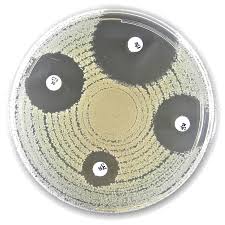Specifications:
| Application | Antimicrobial Susceptibility and Resistance Testing (AST) |
| Storage Temperature | -20°C |
| Product Type | Antibiotic Disc |
| Product Brand | Liofilchem |
| Product Grade | Microbiology grade |
The Liofilchem® AmpC Disc Kit is a specialized diagnostic tool designed to confirm the presence of AmpC β-lactamase-producing organisms. AmpC β-lactamases are enzymes found in Enterobacteriaceae and some other bacteria, which confer resistance to a broad spectrum of β-lactam antibiotics, including penicillins, cephalosporins, and cephamycins.
This disc diffusion-based test uses cefotaxime and ceftazidime discs, both alone and in combination with cloxacillin, to detect AmpC enzyme activity by measuring inhibition zones. The test is a critical tool in antimicrobial susceptibility testing (AST) and antibiotic resistance surveillance in clinical microbiology laboratories.
Key Features & Benefits
✔ Accurate & Reliable – Provides a simple, effective method for confirming AmpC β-lactamase production.
✔ CLSI & EUCAST Compliant – Follows internationally recognized guidelines for resistance detection.
✔ Easy-to-Use – Standardized disc diffusion test for quick and efficient interpretation.
✔ Broad Application – Used in clinical, veterinary, and pharmaceutical microbiology for antibiotic resistance detection.
✔ Quality Control Approved – Includes reference strains for validation of results.
Background: Understanding AmpC β-Lactamases
AmpC β-lactamases are Class C β-lactamase enzymes that hydrolyze a wide range of β-lactam antibiotics, making standard treatments ineffective. Unlike Extended-Spectrum β-Lactamases (ESBLs), AmpC enzymes are resistant to β-lactamase inhibitors like clavulanic acid, sulbactam, and tazobactam, but they are strongly inhibited by boronic acid and cloxacillin.
AmpC-producing organisms are commonly found in:
- Enterobacter spp. (E. cloacae, E. aerogenes)
- Citrobacter freundii
- Serratia marcescens
- Morganella morganii
- Providencia spp.
- Some Escherichia coli and Klebsiella pneumoniae isolates
These bacteria are often multidrug-resistant (MDR), posing a serious challenge in hospital-acquired infections (HAIs).
Principle of the AmpC Disc Test
The Liofilchem® AmpC Disc Kit works by comparing the inhibition zones of cefotaxime (CTX) and ceftazidime (CAZ) discs alone versus in combination with cloxacillin (CTC and CAC).
Mechanism of Action
- Cloxacillin inhibits AmpC β-lactamase activity.
- If the bacterial strain produces AmpC enzymes, cephalosporins alone (CTX & CAZ) will be hydrolyzed, leading to small inhibition zones.
- When combined with cloxacillin (CTC & CAC), AmpC inhibition results in a larger inhibition zone (≥ 5 mm increase), confirming AmpC production.
This test differentiates AmpC-positive and AmpC-negative strains, aiding in appropriate antibiotic selection.
Kit Contents & Specifications
The Liofilchem® AmpC Disc Kit includes:
✅ 4 x 50 disc cartridges (total 200 discs)
✅ Individually packaged blister packs with a desiccant to maintain stability
✅ Disc types & concentrations:
- Cefotaxime 30 μg (CTX) – 50 discs
- Cefotaxime 30 μg + Cloxacillin (CTC) – 50 discs
- Ceftazidime 30 μg (CAZ) – 50 discs
- Ceftazidime 30 μg + Cloxacillin (CAC) – 50 discs
Test Procedure: Step-by-Step Guide
1. Sample Preparation
- Use a fresh, pure culture of the test organism.
- Prepare a bacterial suspension equivalent to 0.5 McFarland Standard.
- Use a sterile cotton swab to evenly inoculate a Mueller-Hinton II agar plate.
2. Disc Application
-
Apply the following discs:
- CTX (Cefotaxime 30 µg)
- CTC (Cefotaxime + Cloxacillin 30 µg)
- CAZ (Ceftazidime 30 µg)
- CAC (Ceftazidime + Cloxacillin 30 µg)
- Ensure sufficient spacing between discs to allow for accurate zone measurement.
3. Incubation
- Incubate the plate at 36 ± 1°C for 18-24 hours.
4. Interpretation of Results
After incubation, measure the zones of inhibition around each disc:
✅ AmpC Positive:
- Increase in inhibition zone ≥ 5 mm for CTC vs. CTX and/or CAC vs. CAZ
❌ AmpC Negative:
- No significant difference (< 5 mm) in inhibition zones
Quality Control Strains for AmpC Testing
- Enterobacter cloacae ATCC® BAA-1143 (+) AmpC producer
- Escherichia coli ATCC® 25922 (−) Non-AmpC producer
Applications & Use Cases
1. Clinical Microbiology Laboratories
- Hospitals & diagnostic labs use the test to confirm AmpC production in urinary tract infections (UTIs), bloodstream infections, and pneumonia caused by Enterobacteriaceae.
- Results help guide antibiotic therapy, preventing the use of ineffective β-lactams.
2. Infection Control & Antibiotic Stewardship
- Identifies multidrug-resistant (MDR) strains for hospital infection control programs.
- Supports antimicrobial resistance (AMR) surveillance efforts.
3. Veterinary & Pharmaceutical Microbiology
- Detects AmpC-producing bacteria in veterinary infections.
- Used in pharmaceutical research to evaluate antibiotic efficacy.
Limitations & Precautions
🔸 In vitro test – Cannot fully replicate in vivo conditions.
🔸 Several variables influence results, including media composition, incubation conditions, and disc potency.
🔸 Used only by trained professionals in microbiology laboratories.
🔸 Storage:
- Unopened: Store at -20°C to +8°C (until expiry date).
- Opened cartridges: Store at 2-8°C for up to 7 days.
Ordering Information
| Description | Packaging | REF | No. of Tests |
|---|---|---|---|
| Cefotaxime 30 μg (CTX) | 1 x 50 Discs | 99009 | 50 |
| Cefotaxime + Cloxacillin (CTC) | 1 x 50 Discs | 99009 | 50 |
| Ceftazidime 30 μg (CAZ) | 1 x 50 Discs | 99009 | 50 |
| Ceftazidime + Cloxacillin (CAC) | 1 x 50 Discs | 99009 | 50 |
The Liofilchem® AmpC Disc Kit is an essential tool for microbiologists to detect and confirm AmpC β-lactamase-producing organisms. It enables accurate antibiotic resistance testing, supporting infection control, research, and antimicrobial stewardship programs.




 0
0
